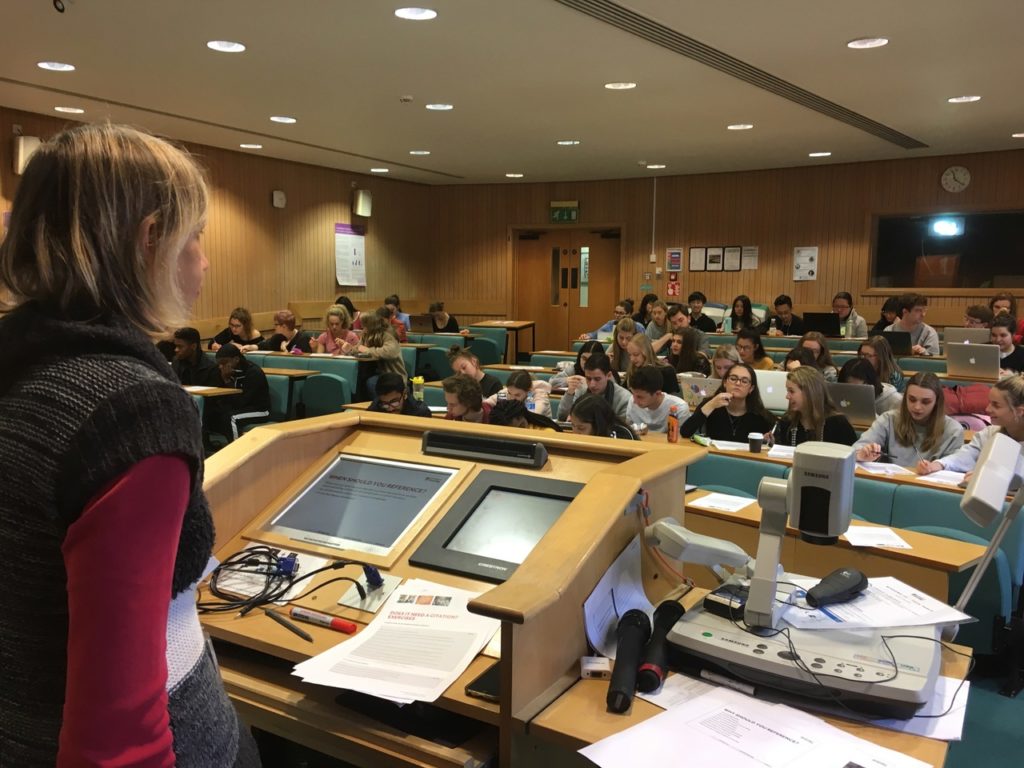In Typography at the University of Reading, a huge importance is placed on having a good academic writing ability. Week four and five of the Baseline Shift sessions therefore aimed to sharpen the writing skills of students, with talks on professional writing and referencing.
Week four kicked off with ‘Let’s eat Grandma!’, a talk from Kim Shahabudin from Study Advice. This session focussed on academic and professional writing, specifically the role and importance of clear communication.
Students were asked to choose one word to describe academic writing and a word cloud was produced. This incorporated the views of all students, with the bigger words representing a larger number of people who all responded with the same word.

From punctuation, spelling and grammar to writing styles and the impressions they give to others, the talk really covered a wide range of points. The importance of appropriate word choice and good paragraph structure was also emphasised.
‘I didn’t expect such basic things to be enforced so much’ – Joanne, Part 1
Typography student’s knowledge was put to the test with an interactive quiz to reinforce the information that had been given, with prizes on offer for the winners!
Following this, week five played host to a very important talk on referencing. The talk was led by Karen Drury, one of the Department of Typography’s two Liaison Librarians.

The talk included vital information for students of all years across the department, with as much as 20% of first year essay marks being dedicated to referencing. Even more so for Part 3 students, who are currently working hard on their dissertations.
The talk covered all bases of referencing including how, when and why referencing should be used as well as different styles of referencing, which involves guidelines as to how the information in the reference should be structured (the Harvard style being favoured within the department!)

As a little reminder, the Harvard referencing system is structured as follows:
Author (Last name followed by first initial), year published, title of work, place of publication, name of publisher, pages used
For sources such as journal articles, the publication information is replaced by the journal title, volume and issue numbers. Websites are also slightly different, the date the source was accessed must be included as well as the URL it can be found at.
Talking to some members of Part 1 after the talk, it became clear that, before university, referencing was not as strictly enforced as it is here.
‘I’ve done referencing in the past, but it was never this rigid and strict’ – Joanne, Part 1
Being from a department such as typography, the materials we are required to reference are often different to that in other fields. As well as the more common sources such as books, journal articles and websites, Karen really clarified how we should go about citing materials such as pictures and artworks. She emphasised the basic reference structure which involves four major pieces of information: author, date, title and publication details (such as the place of publication and the name of the publisher although this varies depending on the item being referenced).
Through interactive quizzes, handouts and a variety of examples, Karen really simplified the referencing process, giving students a greater understanding of what is involved in citing correctly.


‘Learning about the specific reference structure to use was really helpful, and the quiz really helped consolidate all of the information given in the talk’ – Ruth, Part 1
Karen also recommended some different tools which are available to assist in referencing such as reference managers (Endnote online, Mendeley and many others). There are also some library guides available as www.libguides.reading.ac.uk which can help in managing and citing referencing.
‘The different tools Karen spoke about will be really helpful, I didn’t know about all of the library resources which are available’ – Caitlin, Part 1
Overall the past two weeks have offered some very key information which is applicable in all areas of study. From Part 1 and 2 essays and reports all the way up to Part 3 dissertations, Typography students at the University of Reading now have a much more solid understanding of how best to structure and communicate written information.

